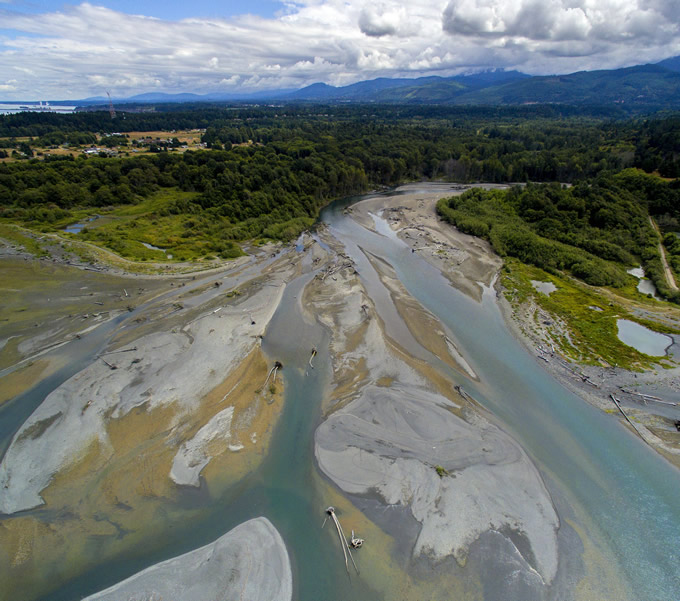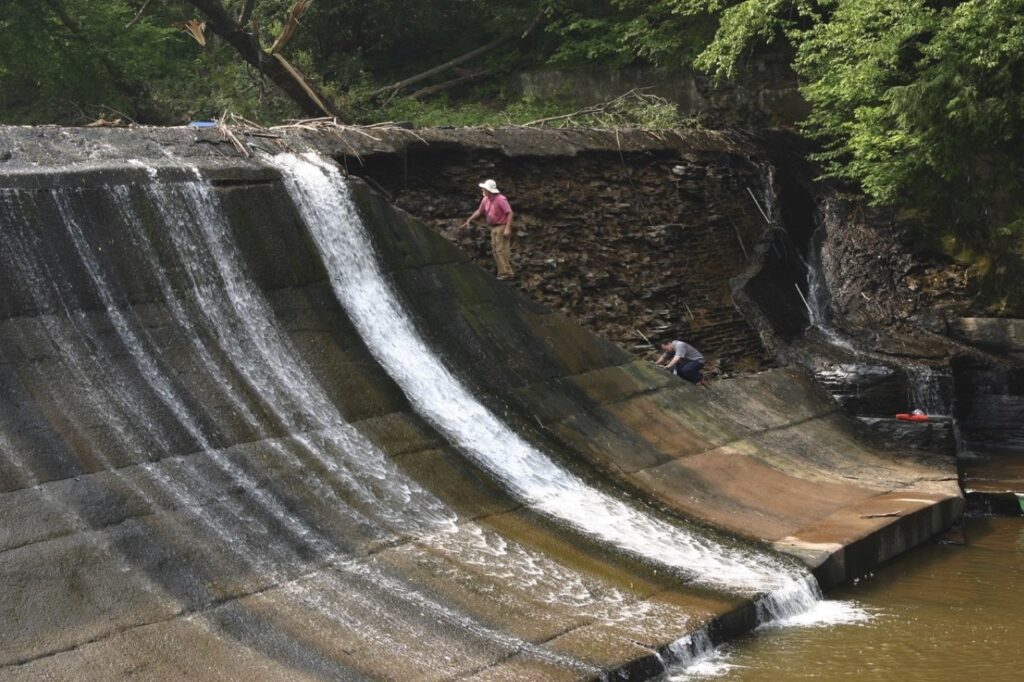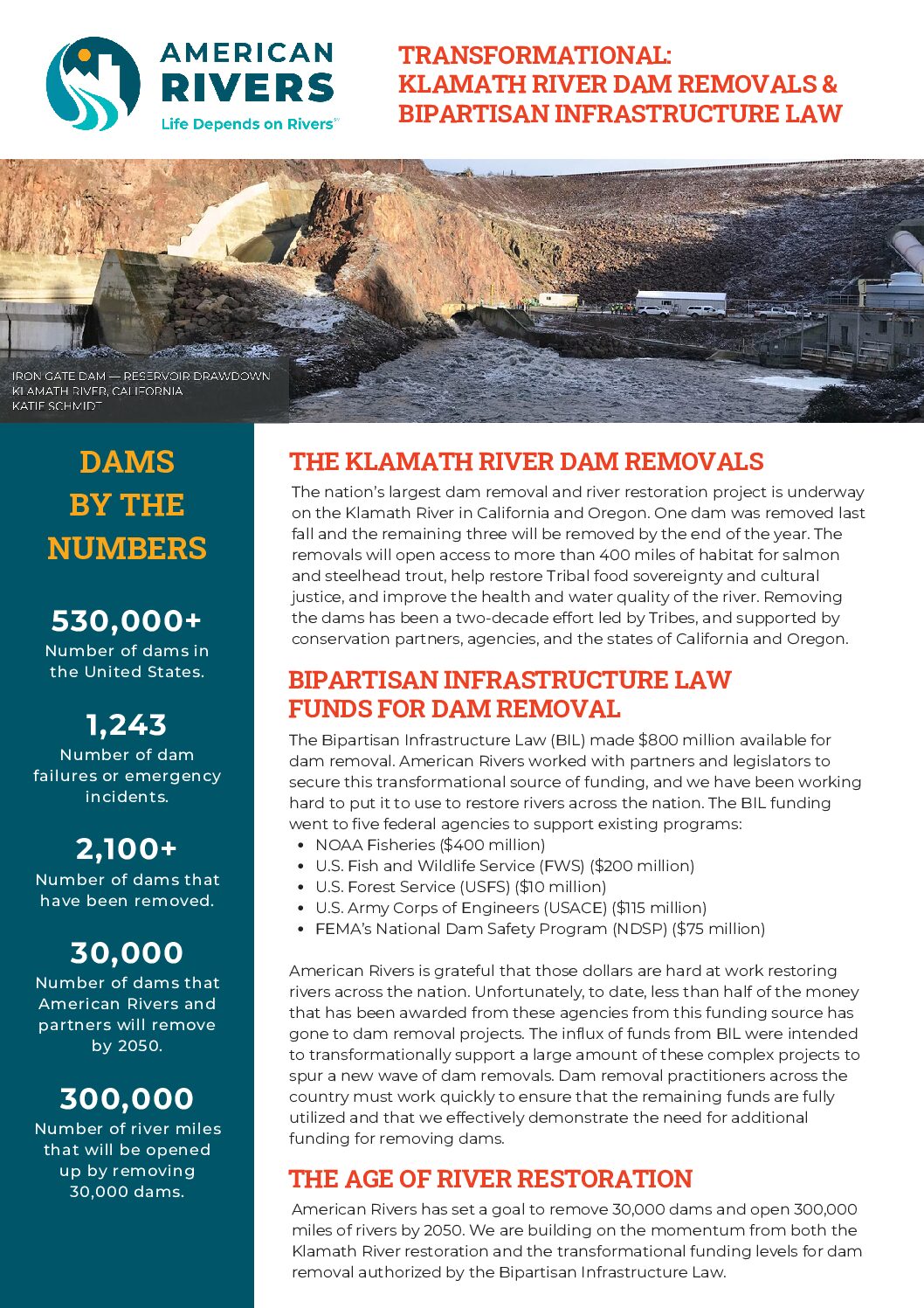Progress Report: two years in to the Bipartisan Infrastructure Law
Giddy smiles and stomping feet. We stood next to the Klamath River and watched muddy water rush out from the tunnel under the Iron Gate Dam. The twenty-degree weather couldn’t freeze out the excitement of our group; even as we tried to kick feeling back into our toes, an energy pulsed through us as we watched part of the largest dam removal and river restoration project in history take place.
Our American Rivers dam removal team visited the Klamath River on Thursday, January 11, 2024. This was the first day water was released from the Iron Gate Dam reservoir in preparation for removing the dam. As with every dam removal, there are short term impacts for long term gain. The mud, the sediment: this is normal and expected. This is the river healing itself. And based on the successes we’ve seen with other dam removals – from Oregon’s Sandy River to Washington’s Elwha and White Salmon – we expect the Klamath to come back stronger than ever.
One dam on the Klamath was removed this fall and the remaining three will be removed by the end of the year. The removals will open access to more than 400 miles of habitat for salmon and steelhead trout, help restore Tribal food sovereignty and cultural justice, and improve the health and water quality of the river. Removing the dams has been a decades-long effort instigated by Indigenous grassroots advocates, led by Tribes, and supported by conservation partners, agencies, and the States of California and Oregon.
The Klamath River restoration project sets the bar high and is kickstarting a renewed energy to restore and protect rivers through dam removal across the nation.
American Rivers has set a goal to remove 30,000 dams and open 300,000 miles of rivers by 2050. We are building on the momentum from both the Klamath River restoration and the transformational funding levels for dam removal authorized by the Bipartisan Infrastructure Law (BIL).
One dam on the Klamath was removed this fall and the remaining three will be removed by the end of the year. The removals will open access to more than 400 miles of habitat for salmon and steelhead trout, help restore Tribal food sovereignty and cultural justice, and improve the health and water quality of the river. Removing the dams has been a decades-long effort instigated by Indigenous grassroots advocates, led by Tribes, and supported by conservation partners, agencies, and the States of California and Oregon.
The Klamath River restoration project sets the bar high and is kickstarting a renewed energy to restore and protect rivers through dam removal across the nation.
American Rivers has set a goal to remove 30,000 dams and open 300,000 miles of rivers by 2050. We are building on the momentum from both the Klamath River restoration and the transformational funding levels for dam removal authorized by the Bipartisan Infrastructure Law (BIL).
I am so grateful and excited to be part of this pivotal moment in river restoration history. Enthusiasm alone does not cut it, however. Though nearly everyone in our country lives within a mile of a river, there is a large gap in the public knowledge on what rivers provide and the importance of restoring and protecting them. I have conversations with folks about this all the time. I have these conversations with members of Congress and their staff, with new partners and dam owners, and sitting on my front porch with friends as we watch our kids run around. Someone asks why I care about dams and I get to share that removing a dam is the fastest way to restore a river.
I want to share a few details of why dam removals are necessary, the benefits provided by these projects, and how we are working together to remove more dams than ever before.
Why Dam Removals are Necessary

More than 530,000 dams block rivers across our country.i Of the 91,843 dams large enough to be included in the National Inventory of Dams, only 19% provide flood risk reduction, 18% provide irrigation or water supply, and 3% provide hydropower.ii Many other dams provide other important services, but these percentages show that many no longer do – possibly more than half of them no longer provide the services they were built to provide decades to centuries ago if you consider the other 440,000 smaller dams that are not in the National Inventory. Too many dams have reached the end of their useful lives and pose public safety risks, negatively impact fish and other aquatic life, and can be costly liabilities to their owners. Countless dams are abandoned, not profitable, or require costly repairs and upgrades that push dam owners to consider removal. Removing dams restores native aquatic life to rivers, increases climate resilience, and reduces the risk of aging dams failing and causing catastrophic flood damages and even loss of human life.
Rivers are dynamic and start to come back to life almost immediately after a dam is removed.iii
Benefits of Removing Dams
- Safety for communities. Dam removal is a permanent dam safety solution. In the last few years alone, dam failures or near failures have forced hundreds of thousands of people to evacuate, caused millions of dollars of property damage, and loss of life.iv In addition, hundreds of drownings have occurred at low-head dams because of the dangerous forces caused by flow hydraulics downstream of the dams.v
- Fisheries, wildlife, and natural heritage. Dams are a major cause of species decline in U.S. rivers, from migratory fish like salmon and herring, nonmigratory fish like trout, and other aquatic species like freshwater mussels. Removing dams is a proven approach to restoring healthy conditions for native river species, with documented results showing increases in fish and other aquatic species populations.vi,vii
- Tribal rights. In a continued effort to more equitably consider Tribal Nations’ water, fishing, and cultural rights, focusing some of these incentives on dam removals where Tribal rights have been infringed allows us to begin to resolve some of these ecological and cultural impacts.
- Jobs. Removing a dam is an intensive infrastructure endeavor providing construction, engineering, scientific, planning, and other jobs. Dam removal projects support 12 to 15 jobs per $1 million invested.viii
- Climate resilience for rivers. Free flowing rivers that are connected to their floodplains are better able withstand the impacts of climate change by limiting and controlling flooding.ix Because free-flowing rivers do not produce methane, and ponded water does, some dam removals can also reduce potential sources of greenhouse gases.x,xi
Removing 30,000 Dams by 2050
American Rivers set a goal working with our partners to remove 30,000 dams and open 300,000 river miles by 2050. More than 2,000 dams have been removed in the country so far, and we want to increase that by a factor of ten. The transformational funds provided by the Bipartisan Infrastructure Law are helping to meet the momentum of the moment brought on by removing the four dams from the Klamath River.
Why 30,000 dams? I wondered the same thing, at first. The more that the number has sat with me, the more that it makes sense. When you consider that there are more than 530,000 dams in our country, removing 30,000 dams is completely reasonable (less than 6%). If we really want to restore habitat connectivity and water quality and habitat in a meaningful way, we need to remove a lot more dams.
Bipartisan Infrastructure Law Funds for Dam Removal
With the Bipartisan Infrastructure Law (BIL), $800 million was made available for dam removal. American Rivers worked with partners and legislators to secure this transformational source of funding and we have been working hard to put it to use to restore rivers across the nation. The BIL funding went to five federal agencies to support existing programs:
- NOAA Fisheries ($400 million)
- U.S. Fish and Wildlife Service (FWS) ($200 million)
- U.S. Forest Service (USFS) ($10 million)
- U.S. Army Corps of Engineers (USACE) ($115 million)
- FEMA’s National Dam Safety Program (NDSP) ($75 million)
Two years since the bill passed, 89 dam removals have been funded.xii,xiii American Rivers would like to thank each agency for their work to distribute and manage this funding and for their support of dam removal projects. We are grateful that those dollars are hard at work restoring rivers across the nation.
Unfortunately, to date, less than half of the money that has been awarded from these agencies from this funding source has gone to dam removal projects. We have worked with the heads of agencies, regional staff, and partners to address this, yet we continue to see the funds go to more shovel-ready and short-term projects for fish passage. Dam removals are generally large projects that require a lot of funding and several years of work to see the project through from inception to the physical removal of the barrier. The influx of funds from BIL were intended to transformationally support a large amount of these complex projects to spur a new wave of dam removals.
NOAA Fisheries, FWS, and USFS have until 2026 to utilize the allocated funds. With only a few years left, American Rivers and dam removal practitioners across the country must work quickly to ensure that the remaining funds are fully utilized and that we effectively demonstrate the need for additional funding for removing dams.

Dam Removal Projects Across the Nation
American Rivers is grateful for the work achieved thus far, and we need to keep working with partners, agencies, and dam owners to continue this good work. Below are five ongoing projects that demonstrate the need for these resources.
- Cypress Branch Dam, Cypress Branch, Maryland
– Located in the Lower Chesapeake Bay Basin, the dam serves no purpose and is in an advanced state of disrepair. American Rivers is working with the Maryland Department of Natural Resources and the U.S. Fish and Wildlife Service on this project and is seeking funding through the National Fish and Wildlife Foundation and U.S. Fish and Wildlife Service.
- Covington Millpond Dam and Drakes Millpond Dam, Cottingham Creek and Three Creeks, South Carolina
– Located in the Lower Pee Dee Basin, these two dams were breached by Hurricane Florence and continue to prevent aquatic organism passage. Both dam owners are engaged in the process and American Rivers is seeking funding from NOAA Community-based Restoration Program. Removal of these dams would reduce flood risk to downstream communities and infrastructure, and also restore natural flows to approximately 100 square miles.
- Powell Dam and Junction Falls, Kinnickinnic River, Wisconsin
– Located in the Lower St. Croix River Basin, Junction Falls produces 1% of energy needs for the community and Powell Dam was decommissioned in 2022. The owner of the dams, City of River Falls, has resolved to remove both dams as part of a major river restoration plan. The dam owners are working with the Kinni Corridor Collaborative and are seeking funding from USACE, programs funded by the Bipartisan Infrastructure Law, and other public and private funding sources.
- Scott Dam and Cape Horn Dam, Eel River, California
– Located in the Upper Eel River Basin, these potential dam removals would make the Eel River California’s longest free flowing waterway. Federal funding is critical to support restoration of the Eel River watershed after PG&E has removed its in-water facilities. California Trout, Trout Unlimited, and American Rivers are working with a broad coalition to support dam removal.
- Lake Jefferson Dam, East Branch Callicoon Creek, New York
– Located in the Upper Delaware River Basin, this is an unsafe and uneconomical high hazard potential dam that is nearly a century old and has no fish passage. The dam owners are fully committed to removal and have sought assistance from American Rivers and FWS to remove the dam. American Rivers is seeking funding through NOAA Community-based Restoration Program, FWS, and additional sources.
The Age of River Restoration
Twenty-five years ago, people just like me sat on the banks of the Kennebec River, listening to the bells toll from downtown Augusta, Maine as the first notch came out of the Edwards Dam. That day launched a movement to remove dams across the country and restore the rivers on which they were built and over 1,800 dams have come out since then.xiv
The dam removals and river restoration on the Klamath River in Oregon and California is an opportunity to kickstart a new wave of dam removals at an unprecedented level. The BIL funding is a down payment and we will all need to work together to secure funding and support for restoring rivers for generations to come.
Removing a dam is the fastest way to restore a river back to life and free-flowing rivers are critical to support biodiversity and climate change adaptation. Life depends on rivers and rivers depend on us to remove dams.
I am hopeful for our future, and for future generations, that we can look back on this moment and know that we are working to restore rivers for the benefit of all. For additional information on the National Dam Removal Community of Practice and our webinars on dam removal, please see www.americanrivers.org/DamRemovalCOP
[i] Southeast Aquatic Resources Partnership, National Aquatic Barrier Inventory and Prioritization Tool, www.aquaticbarriers.org
[ii] U.S. Army Corps of Engineers, National Inventory of Dams, https://nid.sec.usace.army.mil/#/
[iii] O’Connor, J.E., J. J. Duda, and G. E. Grant. (2015). 1000 dams down and counting: Dam removals are reconnecting rivers in the United States. Science 348(6234), 496-497. http://dx.doi.org/10.1126/science.aaa9204
[iv] Association of State Dam Safety Officials, Dam Incident Database Search, https://damsafety.org/Incidents
[v] American Society of Civil Engineers, National Inventory of Low Head Dams, https://www.asce.org/communities/institutes-and-technical-groups/environmental-and-water-resources-institute/national-inventory-of-low-head-dams
[vi] NOAA Fisheries, Successful Fish Passage Efforts Across the Nation, https://www.fisheries.noaa.gov/insight/successful-fish-passage-efforts-across-nation
[vii] McCombs, Erin, Dam removal and freshwater mussels: effective restoration and prioritization through case studies, https://scholarworks.umass.edu/fishpassage_conference/2014/June10/46
[viii] Value of Water Campaign, The Economic Benefits of Investing in Water Infrastructure, https://thevalueofwater.org/media/new-analysis-finds-closing-investment-gap-water-infrastructure-would-create-13-million-jobs
[ix] Ganey, S. and L.Spurrier, PEW, 8 Benefits of Healthy, Free-Flowing Rivers, https://www.pewtrusts.org/en/research-and-analysis/articles/2022/09/22/8-benefits-of-healthy-free-flowing-rivers
[x] Environmental Protection Agency, Research on Emissions from U.S. Reservoirs, https://www.epa.gov/air-research/research-emissions-us-reservoirs
[xi] Levasseur, A. et al. (2021). Improving the Accuracy of Electricity Carbon Footprint: Estimation of Hydroelectric Reservoir Greenhouse Gas Emissions. Renewable & Sustainable Energy Reviews, 136 (2021) 110433. https://doi.org/10.1016/j.rser.2020.110433
[xii] U.S. Fish and Wildlife Service, Fish Passage Portal, https://interagency-bil-fish-passage-project-1-fws.hub.arcgis.com/
[xiv] American Rivers is internally tracking and has found 89 dams are funded for removal
[xv] American Rivers, American Rivers Dam Removal Database, https://figshare.com/articles/dataset/American_Rivers_Dam_Removal_Database/5234068
[xvi] National Inventory of Dams, https://nid.usace.army.mil/#/
[xvii] Southeast Aquatic Resources Partnership, National Aquatic Barrier Inventory and Prioritization Tool, www.aquaticbarriers.org
[xviii] Association of State Dam Safety Officials, Dam Incident Database Search, https://damsafety.org/Incidents [1] American Rivers, Dam Removal Database, https://figshare.com/articles/dataset/American_Rivers_Dam_Removal_Database/5234068




